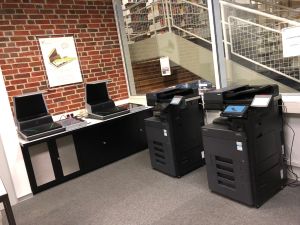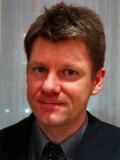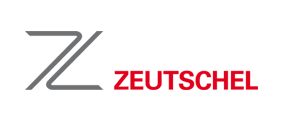Apil 2020 - Overhead scanners are irreplaceable for copying, printing and scanning operations
Application at the Vechta University Library
 |
Overhead scanners protect books, ease the burden on the environment and facilitate contemporary, digital media products, performing crucial tasks in the public areas of many libraries. The success story of the Vechta University Library shows just how significant this added value is for students and library operators and what factors are important when using a scanner. On the one hand, literature has to be available, up-to-date and driven by demand; and on the other, there are only limited funds available. This the force field within which many libraries must maneuver – all the more important to look after resources and keep them usable for as long as possible. |
The Vechta University Library began work early on, adding copying and printing services to its infrastructure. Books and magazines suffer continual wear and tear from frequent copying on traditional multi-function devices. Overhead scanners offer a decisive advantage here: they permit contactless digitizing.
Focus on sustainability and digitization
Sustainability issues also favor the use of overhead scanners. The Vechta University Library campaigns for greater sustainability in all functional areas – from teaching and research via admin to the physical design of the campus and library. Criteria for a sustainable IT plays a major role in the procurement of hardware.
 |
“Overhead scanners offer major sustainability advantages,” explains AP Dr. Gunther Schmidt, Head of the Data Center at the University of Vechta. “If more high-quality digital copies are available, there will be less printing. This way we actively save on CO2 emissions.” He adds: “One of the ways we support this is by not charging any fee for using the overhead scanners to employees and students.” Thirdly, overhead scanners help libraries provide a contemporary range of services: “Students and researchers today expect to get digital copies for their academic work quickly and without any fuss. Overhead scanners allow us to advance this trend towards digitization in research and teaching,” emphasizes AP Dr. Gunther Schmidt. |
In 2013, a total of eight overhead scanners from Zeutschel – most of them from the zeta model series – were installed in the public area of the library aside the existing multi-function units. Seven years later, the experience of the Vechta University Library shows how important an optimal mix of powerful devices and the expert support of an external partner are for the success of a project.
Operating concept as for a smartphone or tablet
When selecting the scanners, the project managers focused on three criteria: operation, image quality and connection to the copy card system.
Operation: “The only devices we can consider for use in the public area are units that can be operated by the users themselves. Even occasional users must be able to operate the scanners quickly and easily,” explains Dr. Schmidt.
The Zeutschel zeta impresses here with a modern operating concept. The scanner can be operated intuitively and barrier-free via a laterally attached touchscreen. The menu is self-explanatory.
Image quality: The pre-installed software provides additional operating comfort. It automatically straightens originals that have been placed at an angle. The “Perfect Book” correction of any book fold distortion is managed by the software program, enhancing practicality and consigning the annoying compression of letters in the middle of an open book scan to history.
With these functions and a standard resolution of 300 ppi in color, which can be increased to 600 ppi, users receive high-quality digital images.
Says Dr. Schmidt: “There is a very clear reciprocal relationship between handling, image quality and acceptance by students. The easier the scanners are to use and the higher the image quality, the more intensively the scanning systems are used.”
Copy card for pay per use (UniCard) integration
 |
Integrating the overhead scanners with the copy card solution proved to be a major challenge for the project. This ensures that print orders can be issued to the multi-function devices and also billed. “We had to develop a separate interface to guarantee communication between the two systems”, states Danilo Wolf, sales operative at ISFORT GmbH & Co. KG. This traditional dealer and systems integrator in the office environment is responsible for the operation of the entire infrastructure for copying, printing and scanning in the Vechta University Library. “This was a highly complex task, and we devoted a lot of time and resources to it,” Danilo Wolf explains. “But in the end, all the effort was worth it,” he continues. “The communication is working perfectly. And we were able to acquire valuable know-how that will be helpful in other projects.” |
From Scan2USB via Scan2Mobile to Scan2Print
Since the overhead scanners have been installed, students at the University of Vechta have been able to make heavier use of digital media products for their academic work.
The overhead scanner can be used by inserting the UniCard into a card reader connected to the scanners. There are several output options available after the scan is complete: storage on connected USB sticks (Scan2USB), dispatch by email (Scan2Mail) and filing on smartphones or tablets (Scan2Mobile). In the case of Scan2Mobile, the scanned pages can be sent directly to mobile devices. For this, Zeutschel offers a zeta2mobile app for Android and iOS operating systems. All digitally produced copies are free of charge for students.
Fees are only charged if the copies are printed out on the multi-function units. The card series number is used to allocate the print order to an individual user. This number is also transmitted when the print order is sent by the overhead scanner to the print management software. If the user can authenticate themselves at the multi-function device with their UniCard, the print order can be unambiguously assigned to the relevant copy card.
Over 1.5 million digital copies
“The overhead scanners have been very well received by the library users, and they are very widely used”, states Dr. Schmidt.
In six years, a total of 1.5 million digital copies were produced on the eight machines, which is an average of about 21,000 scans per month. On average, one device produced around 187,500 scans in the period 2013-2019, and highly frequented scanners even produce a total of over 300,000 scans.
“The scanners are in operation all day long. In spite of their intensive use, they have hardly ever failed throughout the whole six years,” explains the head of the Data Center.
This achievement is based on proactive servicing with regular software updates and cleaning of the units. ISFORT also stocks the most important spare parts and, if necessary, can respond quickly.
And if a repair takes a little longer, the library receives a replacement unit to use until the repair is finished. ISFORT has invested specially in a loan unit from Zeutschel for this eventuality.
Highly-qualified service technicians are also vital for the smooth operation of copiers, printers and scanners. ISOFORT provides intensive training to their technicians in both the use of multi-function systems and overhead scanners. “This means there is a single point of contact regardless of whether there are questions on scanning with the overhead scanners or the multi-function units. This is very well received by the library,” Danilo Wolf from ISFORT explains.
Infrastructure further modernized
At the end of 2019, the university library took the next step and further modernized its infrastructure as part of a tender.
Besides newly installed multi-function units, the zeta overhead scanners were replaced with the latest generation model. Compared with the first-generation model, the touchscreen for the new zeta is almost twice the size while only marginally increasing the scanner’s surface area. The touchscreen also contains faster processors and an SSD hard disk which further speeds operation.
“The initial feedback from the library is very good. The scanners work even faster and user satisfaction has gone up another notch,” Danilo Wolf explains.
Asked for his conclusion with respect to use of the overhead scanners, Dr. Schmidt’s answer is unambiguous: “Overhead scanners are irreplaceable for copying, printing and scanning operations in the Vechta University Library.”
***
Vechta University Library
Vechta University Library can look back on a long history stretching back to 1947. After 20 years as an external branch of the Osnabrück University Library, this university library has been an independent institution since 1995. Its resources are mainly aligned with the concerns of teaching, studying and researching at the University of Vechta. In addition, the library prioritizes the procurement of literature by and about the author Rolf Dieter Brinkmann (1940 - 1975), non-fiction for children and adolescents as well as gender literature. https://bibliothek.uni-vechta.de/
ISFORT GmbH & Co. KG
ISFORT GmbH & Co. KG is a family business steeped in tradition that has been meeting the office needs of its customers with its products for five decades. Founded in 1966, ISFORT has grown to become a modern business stocking a full range of products with six locations in a total of 20,000 m2. Besides office needs as its core business, ISFORT has expanded its activities to include the areas of office technology, office furnishings as well as DMS and workflow solutions. https://www.isfort.ms
Zeutschel GmbH
With its scanning and microfilm systems, Zeutschel GmbH has played a key role for more than 55 years in the digitization and digital preservation of valuable documents, both in librarianship and archive management as well as in industrial companies and public administration. The company is the global market leader in overhead scanners. The range of software products and accompanying services is extensive and supports libraries and archives in building up digital collections in the Internet and in the realization of digital services. The company, founded in 1961, employs 65 members of staff, and its products and services are represented in more than 100 countries. All Zeutschel products are "Made in Germany": The complete manufacture and entire research and development activities take place at the company's headquarters in Tübingen-Hirschau. https://www.zeutschel.de
